
USS Luzerne County (LST-902) was an LST-542-class tank landing ship built for the United States Navy during World War II. Named after Luzerne County, Pennsylvania, she was the only U.S. Naval vessel to bear the name.

USS LST-31 was a United States Navy LST-1-class tank landing ship used exclusively in the Asiatic-Pacific Theater during World War II. Like many of her class, she was not originally named and is properly referred to by her hull designation. Later she was named for Addison County, Vermont. She was the only US Naval vessel to bear the name.

USS LST-356 was an LST-1-class tank landing ship built for the United States Navy during World War II. She earned three battle stars during the war and was decommissioned in July 1946. In July 1955, she was assigned the name USS Bledsoe County (LST-356) in honor of Bledsoe County, Tennessee, but never saw active service under that name. Bledsoe County was struck from the Naval Vessel Register in September 1960 and sold for scrapping in March 1961. She was apparently sold into commercial service in 1962 instead, serving under several names over the next five years. In 1967, she was acquired by the Indonesian Navy and renamed KRI Teluk Tomini (508). In 2012, the ship was decommissioned and scrapped.

USS LST-900 was an LST-542-class tank landing ship in the United States Navy during World War II. Late in her career, she was renamed Linn County (LST-900)—after counties in Iowa, Kansas, Missouri, and Oregon—but saw no active service under that name.
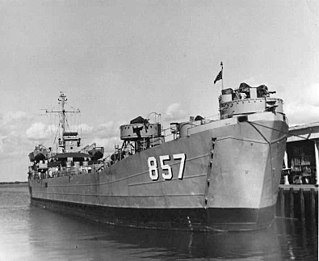
USS King County (LST-857) was an LST-542-class tank landing ship built for the United States Navy during World War II. Named after counties in Texas and Washington, she was the only U.S. Naval vessel to bear the name.

USS Sedgwick County (LST-1123) was an LST-542-class tank landing ship in the United States Navy. Unlike many of her class, which received only numbers and were disposed of after World War II, she survived long enough to be named. On 1 July 1955, all LSTs still in commission were named for US counties or parishes; LST-1123 was given the name Sedgwick County, after counties in Colorado and Kansas.

USS Pitkin County (LST-1082) was an LST-542-class tank landing ship built for the United States Navy during World War II. Named after Pitkin County, Colorado, she was the only U.S. Naval Vessel to bear the name.
USS Park County (LST-1077) was an LST-542-class tank landing ship in the United States Navy. Unlike many of her class, which received only numbers and were disposed of after World War II, she survived long enough to be named. On 1 July 1955, all LSTs still in commission were named for US counties or parishes; LST-1077 was given the name Park County, after a counties in Colorado, Montana, and Wyoming.
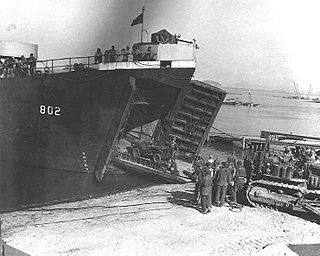
USS Hamilton County (LST-802) was an LST-542-class tank landing ship built for the United States Navy during World War II. Named after counties in Florida, Illinois, Indiana, Iowa, Kansas, Nebraska, New York, Ohio, Tennessee, and Texas, she was the only U.S. Naval vessel to bear the name.
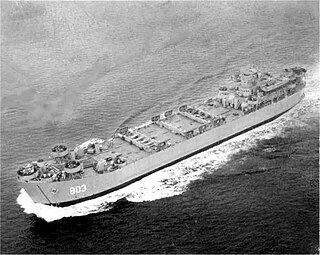
The USS Hampden County (LST-803) was an LST-542-class tank landing ship built for the United States Navy during World War II. Named after Hampden County, Massachusetts, she was the only U.S. Naval vessel to bear the name.
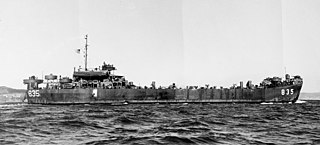
USS LST-835 was an LST-542-class tank landing ship built for the United States Navy during World War II. Late in her career, she was renamed Hillsdale County (LST-835) – after Hillsdale County, Michigan, the only U.S. Naval vessel to bear the name – but saw no active service under that name.
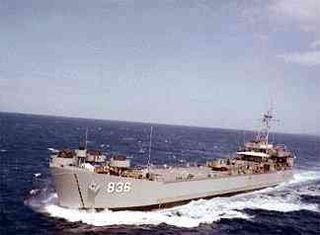
USS Holmes County (LST-836) was an LST-542-class tank landing ship built for the United States Navy during World War II. Named after counties in Florida, Mississippi, and Ohio, she was the only U.S. Naval vessel to bear the name.
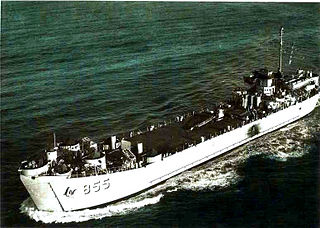
USS Kent County (LST-855) was an LST-542-class tank landing ship built for the United States Navy during World War II. Named after counties in Delaware, Maryland, Michigan, Rhode Island, and Texas, she was the only U.S. Naval vessel to bear the name.
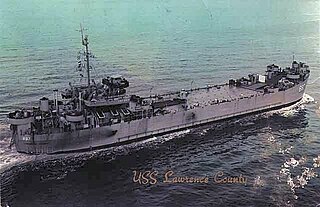
USS Lawrence County (LST-887) was a LST-542-class tank landing ship built for the United States Navy during World War II. Named after counties in eleven U.S. states, she was the only U.S. Naval vessel to bear the name.
USS Lyon County (LST-904) was an LST-542-class tank landing ship built for the United States Navy during World War II. Named after counties in Iowa, Kansas, Kentucky, Minnesota, and Nevada, she was the only U.S. Naval vessel to bear the name.

KRI Teluk Amboina is a tank landing ship of the Indonesian Navy. The ship was built at Sasebo Heavy Industries, Japan and completed in 1961. Its design is a copy of LST-542-class LST, albeit faster than the original. As of 2020, Teluk Amboina is the oldest ship in commission with the Indonesian Navy.

USS LST-678 was an LST-542-class tank landing ship built for the United States Navy during World War II. Later she was converted to Benewah-class barracks ship as USS Presque Isle (APB-44), named after Presque Isle County, Michigan. She was acquired by Indonesian Navy in 1967 as KRI Teluk Ratai (509) and decommissioned in 2019. She is planned to be preserved as museum ship.
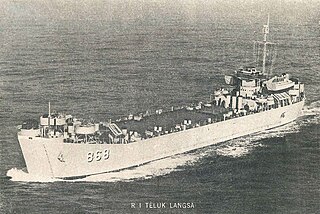
USS Solano County (LST-1128) was a LST-542-class tank landing ship in the United States Navy during World War II. She was transferred to the Indonesian Navy as KRI Teluk Langsa.

The Teluk Langsa-class tank landing ship was a class of tank landing ships which used to be operated by the United States Navy during World War II but were later transferred and sold to the Indonesian Navy in the 1960s and 1970s.
The Military Sealift Command, is an organization that controls the replenishment and military transport ships of the Indonesian Navy. Military Sealift Command has the responsibility for providing sealift and ocean transportation for all Indonesian military services as well as for other government agencies. It first came into existence on 1 July 1961 when the Naval Transport Department was established as the sole service responsible for the Ministry of Defense's ocean transport requirements for both peacetime and war.

















